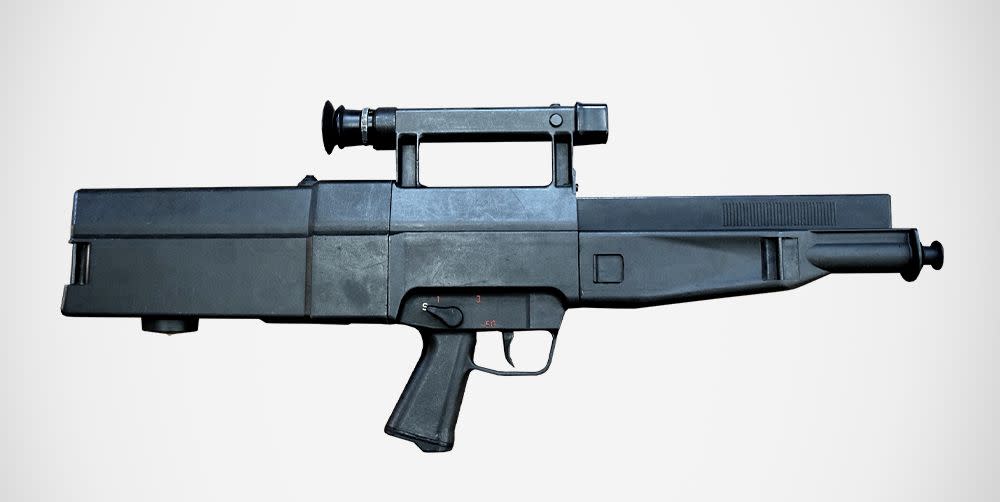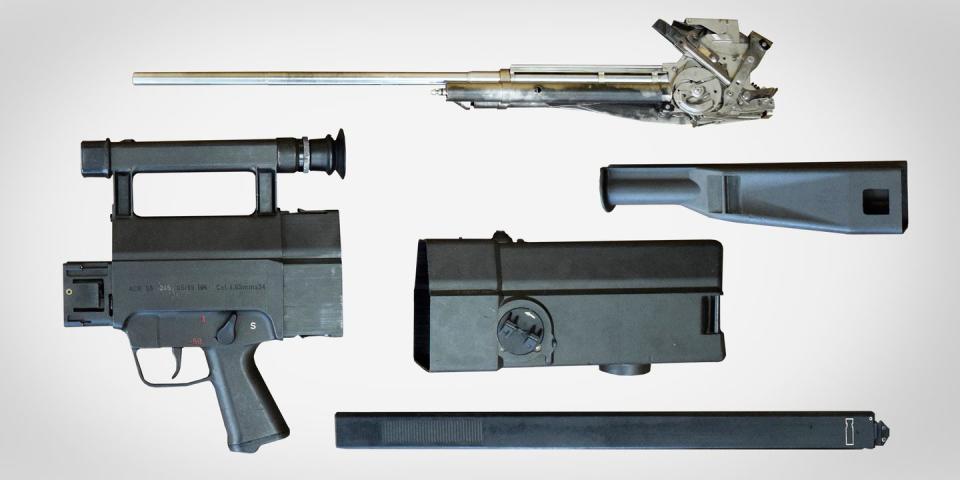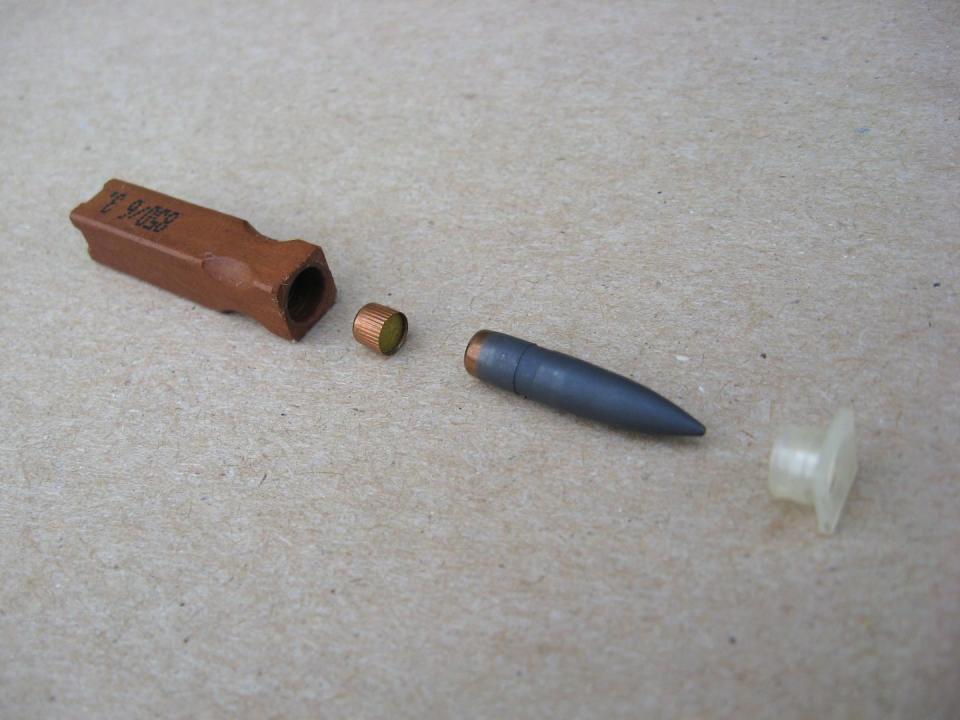We Got Our Hands on an HK G11, the Space-Age Rifle That Never Was

The Cold War gave rise to a host of exotic weapons never fired, but none were quite as strange–and potentially revolutionary—as Heckler & Koch's G11.
Affectionately referred to as "Kraut Space Magic" in reference to its over-engineered-yet-brilliant West German design, the G11 does look like it belongs in the hands of some space trooper rather than a typical infantryman. But the true "magic" of the G11 is much more than meets the eye, because inside that boxy frame was a gun unlike any ever made.
🎖Don't miss our best-in-class military and defense coverage. Join our squadron.
By encasing its ammunition in a chemical propellant rather than a typical brass casing, the G11 was more accurate, efficient, and potentially deadly than any rifle of its time. But even after millions of dollars spent on research and development, the gun never saw combat. After the collapse of the Soviet Union, it mostly passed into obscurity.
The best way to learn about what happened to the G11 and why it was so forward-thinking is to take one apart. There are less than 20 or so G11s left in the world, but we got our hands on one to figure out what makes it tick—and why it was eventually consigned to the scrap heap of history.
What Sets the G11 Apart?

A typical firearm uses brass cases to hold the propellent, which are then topped by the bullet. While a dependable design, and one still in use today, this brass case adds weight to an already overburdened soldier.
But in the late 1960s, German designers from Heckler & Koch tried another approach; they had a working prototype of the G11 by 1974. It was Germany's attempt to combine advanced, case-less ammunition with a brilliantly engineered weapon system that could increase the average infantryman's accuracy. In the 1980s, West Germany would test the weapons system, as would the U.S. Army. In another timeline, the G11 could have been the next-generation replacement for the M16.
The G11 abandoned traditional casing and fired a 4.73-by-33-millimeter case-less round, developed by Dynamit-Nobel, a chemical and weapons company based in Troisdorf, Germany. This new kind of ammo used propellant chemicals, which formed a solid block surrounding the bullet. This design greatly lightened ammunition (a problem gun makers are still trying to tackle 40 years later) and increased the rate-of-fire since no casings needed to be ejected. Combining the one-of-a-kind ammo with a gas-operated rotating breech action, controlled by a recoil buffer system, the G11 could also fire in a single shot, go fully automatic, or shoot in a hyperburst mode.

This last function describes the G11's ability to fire three rounds at the astonishing rate of 2,000 rounds per minute, or around 33 rounds per second. The rifle's case-less ammunition and rotating breech help achieve these blistering rates of fire. By comparison, the M16A1— the U.S. Army's standard rifle at the time—fired around 800 rounds per minute, while the ComBloc AKM cycled at a leisurely 600 rounds per minute.
With hyperburst, the G11's recoil buffer prevented a strong recoil impulse from the three rounds, greatly improving accuracy over normal full-auto fire. The buffer essentially stored the recoil until after the third bullet left the barrel. The recoil was also controlled by a special spring buffer system that allowed the barrel and action of the gun to recoil backward up to four inches inside its stock before the operator felt it.
Inside the Space Magic
The rifle's body is made up of three assemblies. The front assembly supports the magazine, protects the free-floating barrel, and gives the user somewhere to grasp the rifle. The rear assembly protects the G11's action and also has a folding plastic charging tab that allows the user to cock the gun.
But the central assembly is the most important because it houses the trigger mechanism and the integral optical sight. It also has a pair of guide rails inside that support the barrel and action, providing a track for it to recoil along.
Once the breech and barrel assembly is removed from the body, the complexity becomes overwhelming. The G11 is made up of a total of nearly 450 individual parts; 144 of those make up the G11's breech assembly. In comparison to the AK rifles that communist forces once used, the G11 had more than twice the number of parts. The average AKM or AK-74 is made up of just under 100 individual parts. Compared to this Soviet simplicity, the G11 was an engineering marvel. But how this incredibly complex design would have fared in combat will forever remain a mystery.
At the heart of the G11 is what looks like a clump of disks, cogs, gears, and springs. Unlike a conventional firearm—where the action works on a linear principle, with the bolt moving backward to allow a cartridge to move up from the magazine before moving forward again to push the next round into the breech—the G11's breech rotates 90 degrees and the ammunition loads from above. When firing, the gas from the previous shot pushes a piston, which rotates the breech upward and allows a round to drop into the chamber. It then rotates back into alignment with the barrel and is ready to be fired.
This entire mechanical ballet happens in a matter of milliseconds.
The G11's action is so complex that ordinary soldiers were not allowed to completely disassemble the rifle for cleaning or repairs—that required a qualified armorer. Removing the control disk, which sits on top of the breech cylinder, lets you peer into the heart of the G11's action. Once the disk is lifted off and a number of levers have been moved, it's possible to lift out the cylinder itself. The chamber inside the cylinder is actually a replaceable part because with such a high rate of fire, the chamber has a service life of just 3,500 rounds, or roughly 70 full magazines' worth of ammunition.
The Next-Gen Rifle That Never Was
It wasn't the G11's extreme complexity that doomed its adoption, though. It was politics.
With the fall of the Berlin Wall in 1989 and the collapse of the Soviet Union two years later, West Germany began the process of reunification with the formerly communist East Germany, and the huge cost of this endeavor made the adoption of the G11 impossible. Military spending was slashed and without the huge amount of cash needed to manufacture the new, incredibly complex rifle, the future of the G11 evaporated along with the enemy it was designed to fight. At the same time, the U.S. Army's Advanced Combat Rifle program ended inconclusively and the G11 project was abandoned.
But even if the Soviets had stuck around a bit longer, it's unlikely that the G11 would have ever seen widespread adoption because of its extreme mechanical complexity, its poor ergonomics, and its staggering production cost.
Today, the U.S. Army is again developing a Next-Generation rifle and trying to find ways to replace brass casings; the case-less ammunition and ambitious engineering developed for the G11 isn't a part of the program, though. Despite its shortcomings, the G11 remains one of history's most tantalizing "what if" weapons—an ambitious design that attempted to create a weapon 50 years ahead of its time.
You Might Also Like

